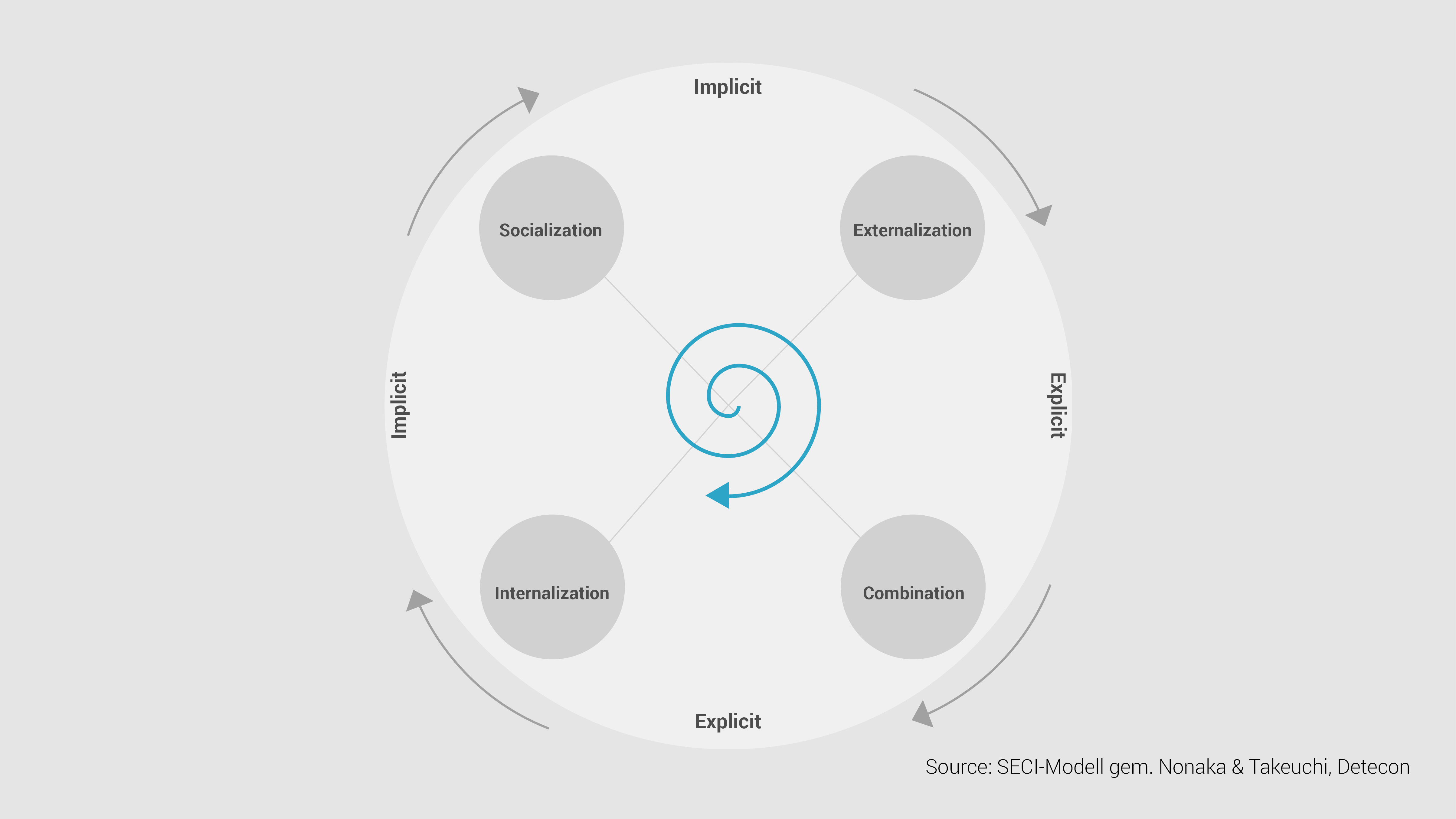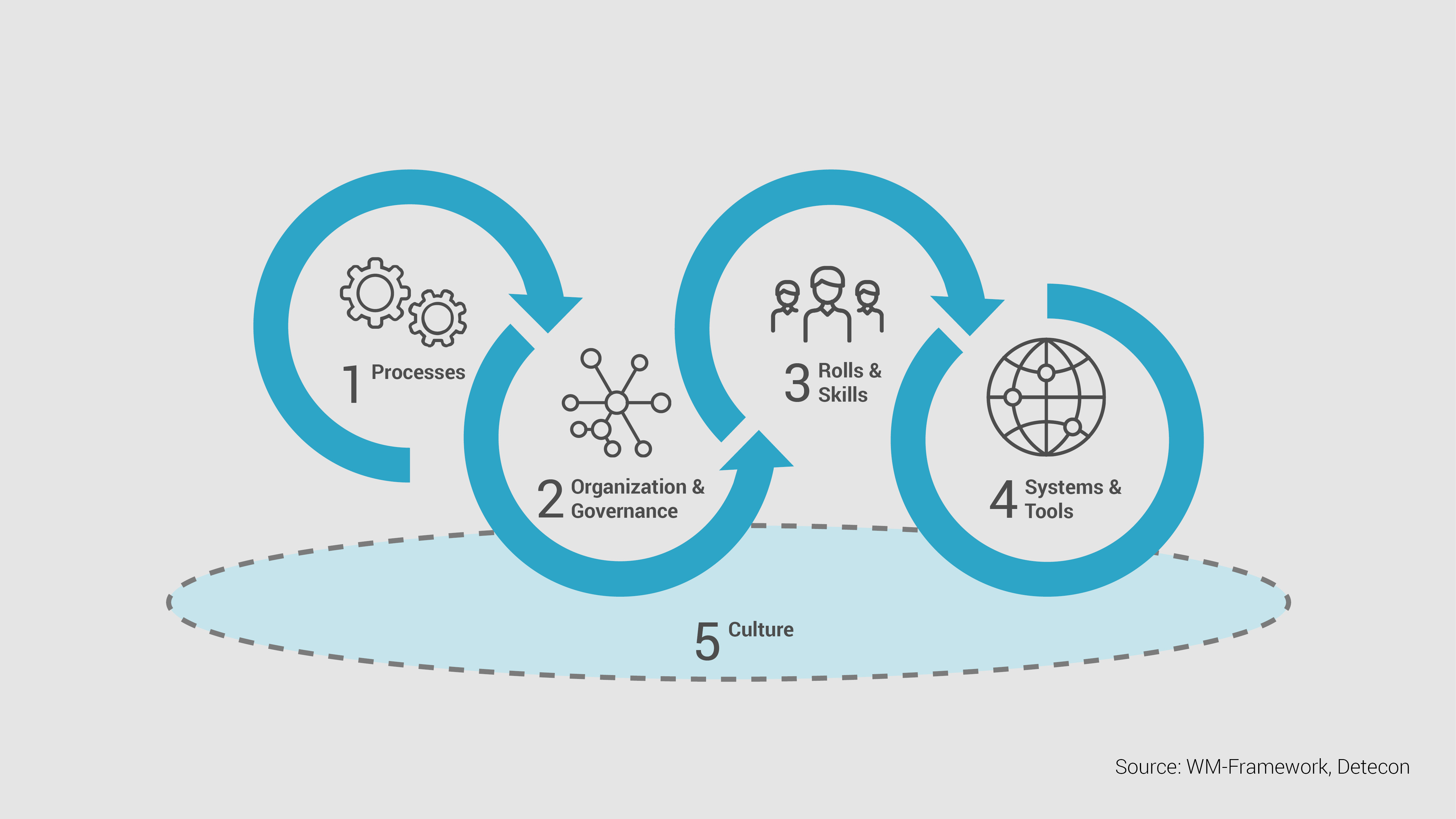The pandemic will (hopefully) soon disappear, but the home office will remain, at least in part. According to the IHK Berlin survey, 50% of the companies surveyed want a hybrid mix with presence and home office times (Results of the IHK survey "Home Office - new normality or back to presence culture?" - IHK Berlin (ihk-berlin.de)). For many employees (MA), this means at least a partial continuation of location-independent or mobile working. Even if many of us welcome the possibility of not having to make a pilgrimage to the office every day, and it has also become clear at decision-making level that many MA are even more productive at home than in the office, the home office does not exclusively bring advantages: 59% of respondents stated this in a Forsa survey commissioned by the DAK. Study Homeoffice | DAK Health. But what does this mean for the organizational knowledge? A strategic resource gets under pressure.
Particularly for newly hired employees, the start in the home office can be accompanied by special initial difficulties. They do not yet know their colleagues personally and initially find it more difficult to find their way around without having colleagues in the office around them.
Typical questions at the beginning of an employment are:
- Where can I find template XY? How can I digitally sign a document?
- Who is responsible for process XY? Where do I store file XY?
- Do we actually have a CRM tool? If so, what login data do I need?
- Does anyone at our company know about topic X?
Questions that in the past would have been casually placed next to the coffee machine or with the person sitting next to you in the first few months in your new office now often require a call to more experienced colleagues. But that doesn't always work, because colleagues are often on a conference call. In addition, the inhibition threshold for a call is significantly higher than for physical interaction - the fear of asking a "stupid" question is significantly greater than in the aforementioned coffee machine situation. Experience has shown that this leads to newcomers spending a lot of time trying to answer questions on their own. Unless the new colleague finds a modern knowledge portal with an intelligent search engine, the odyssey through the often antiquated intranet begins at this point.
However, access to such information is not only essential for new employees; established employees are also frequently dependent on organizational knowledge.
In addition, demographic change is exerting great pressure on existing knowledge in organizations. The most important knowledge carriers are often those who have spent the longest time in the company. Often, these colleagues are close to retirement. Experience shows that very few organizations have an approach to "conserve" this knowledge in time and so in most cases it follows the MA into retirement.
Theoretical foundations
The so valuable resource "knowledge" can be divided into "implicit" and "explicit" knowledge. According to the SECI model (The SECI model of knowledge dimensions (or the Nonaka-Takeuchi model) is a model of knowledge creation that explains how implicit and explicit knowledge are transformed into organizational knowledge. Implicit knowledge, the knowledge of how something works, is passed on through socialization, i.e., by "copying" each other, and externalization, the active imparting or "putting it down on paper." Both are processes that people mostly perform in presence and in common interaction. On the other side of the coin is explicit knowledge. This is all knowledge that can be codified and communicated. It is systematically externalized through language, for example, in records, project documents, instructions for action, checklists, process documentation, protocols, etc.

But how do you successfully manage this valuable, strategic resource? There are many different answers to this question, but there is no "one size fits all" solution.
The scientific spectrum, from business administration and management sciences to psychology and sociology, finds very different answers to the question. At the beginning of the millennium, the topic of knowledge management (hereafter KM) was really hyped in the executive suites of large companies, the post of Chief Knowledge Officer (CKO) became popular, numerous projects were initiated, but their results often fell short of expectations or their implementation even failed altogether. The aforementioned "antiquated" intranets also date back to this time, and many have only received superficial updates since then.
This failure often goes back to a serious mistake of the past: understanding KM as purely tool-driven, or the belief that with the introduction of an intranet platform such as SharePoint or Confluence the topic would be done. KM must be understood holistically.
There are numerous approaches to building a holistic KM. However, successful implementation depends on many individual factors of the organization. What is the business model based on? What is the customer relationship? Which demographic factors play a role? What are the requirements of the long-term corporate strategy?
The KM Framework
In our experience, a tailor-made concept is therefore necessary if knowledge management is to be successfully implemented in the organization. Depending on the needs of the company, this concept should make use of the range of different solutions and integrate them in a meaningful way. It is important to consider the topic holistically from the very beginning. But what does holistic mean in the context of knowledge management?
Detecon has developed a holistic framework based on completed knowledge management projects and with the involvement of experts which can serve as a modular concept for the development of professional knowledge management within an organization - regardless of the industry and type of company under consideration. The framework comprises the five dimensions of processes, organization & governance, roles & skills, systems & tools, and culture and represents an integrated approach that meaningfully links technical, human-oriented, and organizational approaches as well as competence and information management.

The focus of the framework is not on knowledge itself as a largely immaterial resource, but on how it is handled, i.e., knowledge work. Knowledge work is not a linear process with clearly definable process phases or steps, but a fluid interlocking and interaction of more or less conscious knowledge-related activities. The Detecon Framework is used to design the interdependent dimensions mentioned above in such a way that the knowledge-related activities or processes can run as optimally as possible.
The individual dimensions are examined in more detail below.
Processes:
The processes dimension forms the central starting point, since knowledge is generally applied in processes. The first question to ask is how knowledge circulates within the organization and where the relevant knowledge flows are located. On the one hand, knowledge management-specific processes that enable systematic and targeted knowledge transfer (e.g. lessons learned, knowledge retention/expert debriefing, etc.) should be considered and, if they do not exist, established. On the other hand, all other company processes should be successively checked for their knowledge orientation so that knowledge is available where it is needed in the process. A knowledge-oriented design also includes the seamless integration of knowledge management relevant systems & tools that support the application of knowledge in the process.
Organization & Governance:
The Organization & Governance dimension constitutes, in addition to the processes, the structural and regulatory framework and thus significantly defines the handling of knowledge within the organization. The focus is essentially on the design of the actual knowledge management organization, in particular its structure, organizational anchoring and role landscape. In addition, clearly defined governance must be established, which can include, for example, guidelines, a code of conduct, and a KM taxonomy and nomenclature. This is the only way to create a uniform understanding of knowledge management and clarity about how knowledge is handled. But be careful: excessive formalism and rigid specifications can hinder the creative exchange of knowledge; the right balance is crucial here.
Roles & Skills:
The Roles & Skills dimension deals with the players in the knowledge management organization. The aim is to recruit or develop experienced experts (e.g., CKO, knowledge manager, etc.) who can control the knowledge management organization decisively, develop it continuously, and also act as contact persons for all knowledge management issues. These experts should be measured and evaluated on the success of the knowledge management organization, so that a certain level of commitment is ensured. In addition to the knowledge management experts, the topic of skills also applies to all other employees in the company. This is because knowledge management is the responsibility of the entire workforce, and each individual employee can make a valuable contribution. Consequently, dedicated training and education must be designed and offered to train all MAs in the handling of knowledge and to enable them to find their way in the knowledge management world.
Systems & Tools:
The Systems & Tools dimension deals with the intelligent and appropriate use of IT tools to support knowledge management-related processes. Since the application fields of knowledge management (e.g., web content management, document management, search, etc.) are very diverse, it is not enough to select and implement a tool such as Confluence or SharePoint. Rather, it is a matter of identifying the relevant application fields as well as the associated tools and integrating and networking them in a meaningful way to ensure maximum interoperability. Data and interface management will play an important role in this. So it should have become clear by now that systems & tools are not the core of professional knowledge management, as is often mistakenly assumed, but should support the KM infrastructure in a meaningful and effective way.
Culture:
The culture dimension supports the creation of a corporate culture that promotes knowledge. This primarily means opening up opportunities for the employees and showing appreciation for the exchange of knowledge. Due to the fact that the creation and sharing of knowledge is valued and possibly even positively influences one's own standing in the company, associated values such as trust, tolerance, partnership and openness will gradually emerge, which will then in turn manifest themselves in corresponding actions. In addition, executives are also required to set a good example and act as multipliers for the organization. Furthermore, executives must understand knowledge management as an important aspect of their leadership task and establish the necessary framework conditions. Even if the culture apparently has little influence on the framework conditions of knowledge management, it is nevertheless decisive for knowledge management to function and be lived. Knowledge management is primarily based on voluntariness and can therefore not be forced. Only if the culture favors it will the MAs proactively create and share knowledge.
In addition to the design and alignment of the previously described dimensions, it is essential to define a strategy corresponding to the knowledge management framework. The strategy provides the long-term thrust and identifies the key action areas. It is important that it is aligned with the corporate strategy so that the knowledge management organization can fulfill its role as a performance driver.
Outlook
In conclusion, KM is a highly relevant topic for every company and organization, regardless of the industry in which it operates. Knowledge constitutes a strategic resource and can have a considerable influence on the operational performance of the employees and thus ultimately on the success of the company. Therefore, it is important to underpin KM with a strong top management mandate on the one hand and to take a holistic approach on the other. This is the only way to ensure that professional KM can be established and continuously developed.




